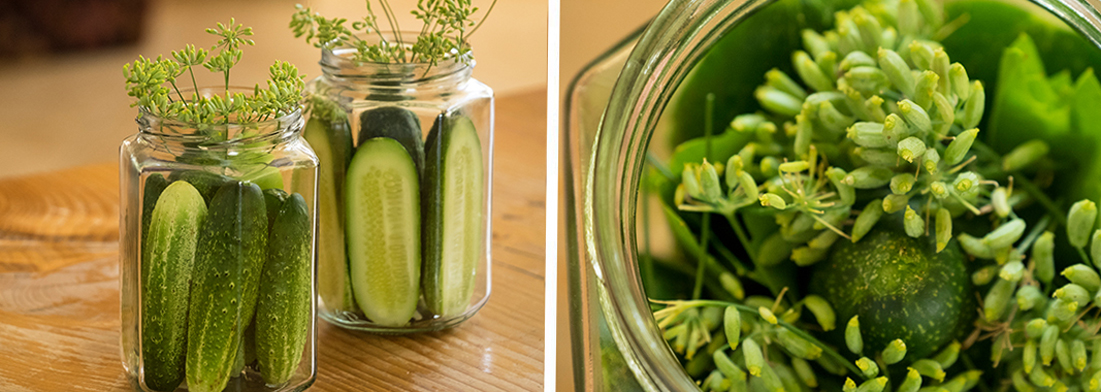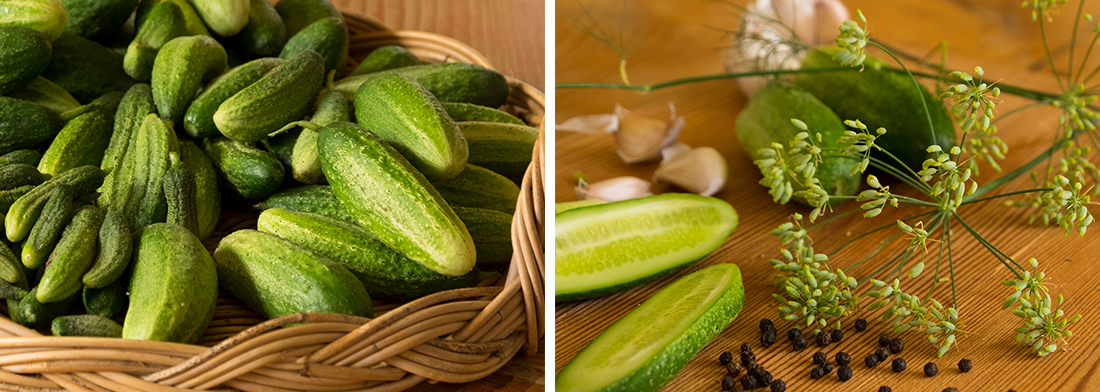Dill Cucumber Pickles - Quick method
- Preserves

Crisp dill pickles infused with garlic and black peppercorns marry perfectly with hot and cold smoked meats and seafood. Thriving in the summer heat, pickling cucumbers need to the picked and processed daily.
This dill pickle recipe is quick and easy as no overnight soaking in brine is required. For a firmer texture add 2 – 3 grape leaves or 6- 8 sour cherry leaves to every 4 cups of pickles.
- Preparation Time:
- 45 minutes
- Cooking Time:
- 10 minutes
- Quantity:
- 2 x 750 ml jars
INGREDIENTS
- 750g
- Pickling cucumbers, approximately 10 cm
- 9
- Black peppercorns, whole
- 10
- Garlic cloves
- 2
- Dried hot chillies, optional
- 2
- Dill heads
- 250 ml
- Apple cider vinegar
- 250 ml
- Water
- 23g
- Preserving salt

METHOD
Wash the cucumbers thoroughly to remove the spiky hairs on the skin. Dry lightly with paper towel or a clean dry tea towel.
Shave 2mm (1/16 inch) from the blossom end of the cucumber and leave approximately 6 mm (¼ inch). Then leave the cucumbers whole or cut into halves or quarters depending upon the size of the cucumbers and jars and the final appearance you want to achieve.
Divide the peppercorns, garlic cloves and chillies (if using them) between the jars.
Pack the cucumbers tightly into the jars.
Roll up the grape leaves or cherry leaves (if using them) and insert into the centre of the jar.
Place the vinegar, water and salt into a saucepan and bring the boil to dissolve the salt.
Place the dill heads into the jar and pour the hot vinegar mixture over the cucumbers, making sure the cucumbers are completely covered. Leaving a 1.25 centimetre (½ inch) from the top of the jar.
Seal the jar and process using the low temperature pasteurisation process
-
When the jars are cold, label and store in a cool dark place in the kitchen or pantry. Allow to mature for at least 4 weeks before eating.
After opening, store in the refrigerator.
NOTES
- The amount of dill, peppercorns, garlic and chilli can be increased or decreased according to taste.
- The blossom end of the cucumbers may contain an enzyme which causes excessive softening of the pickles. Firming agents, pickling lime (hot link) and grape of sour cherry leaves can be used to retain the crispness associated with a good pickle. If using the grape or cherry leaves roll up into a tight cigar shape and pack into the centre of the jar and wedge between the cucumbers.
- Use pickling salt, not table salt, when making pickles and preserves. Table salt contains stabilisers and anti-caking agents and often iodide which form a whitish haze and sediment. These additives and in particular iodine can affect the appearance and taste of pickles and during the maturation and storage period. The ingestion of a cocktail of anti-caking chemicals such as calcium silicate, sodium silicoaluminate, tricalcium phosphate, magnesium carbonate, silicon dioxide and yellow prussate of soda, is also unnecessary. Lite Salt may be used in quick pickle recipes; however it may result in a slightly different taste than expected
- Caution: Use of reduced-sodium salt in fermented pickle recipes is not recommended. The salt creates a favourable environment for the growth of desirable bacteria while retarding in the growth of harmful bacteria. The correct concentration of salt is vital to the textures and food safety.
